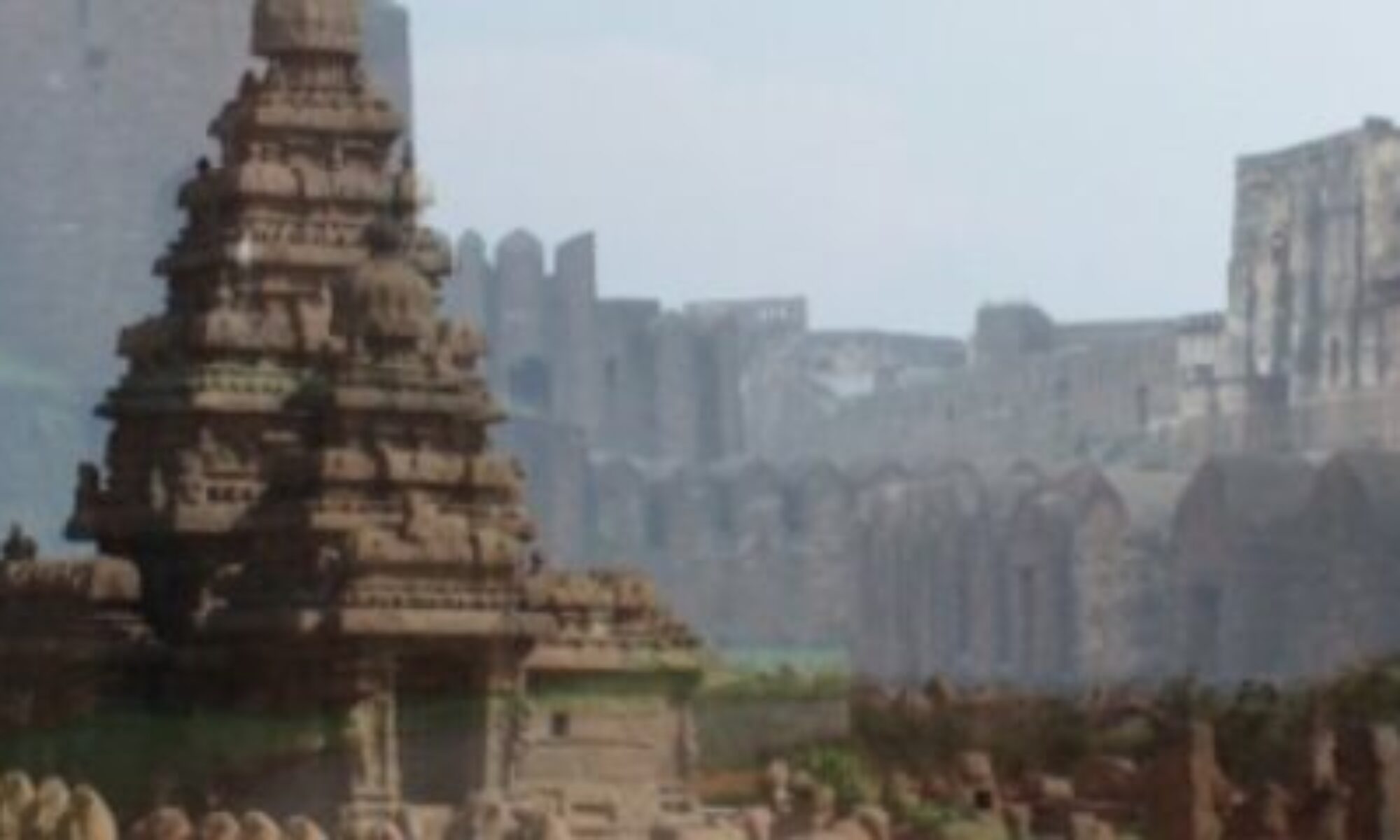This is a large and interesting cave, approached by a flight of steps leading to the top 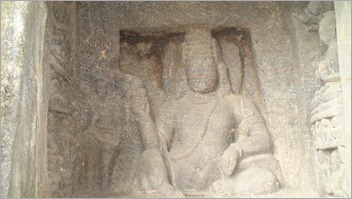 of stylobate, the front of which has been carved in compartments with dwarf figures. On this four pillars with pilasters at the ends, once supported by the roof the verandah, but this is now entirely gone. At the north end of the verandah is a fat squatting figure with a high and elaborate head-dress or mukut, a jeweled cord over his breast, and a bouquet of flowers in his right hand. Right and left are small Buddha images sitting with dwarfs beside. On the south was probably a similar female figure, but now and attendant is only left. These figures are often
of stylobate, the front of which has been carved in compartments with dwarf figures. On this four pillars with pilasters at the ends, once supported by the roof the verandah, but this is now entirely gone. At the north end of the verandah is a fat squatting figure with a high and elaborate head-dress or mukut, a jeweled cord over his breast, and a bouquet of flowers in his right hand. Right and left are small Buddha images sitting with dwarfs beside. On the south was probably a similar female figure, but now and attendant is only left. These figures are often 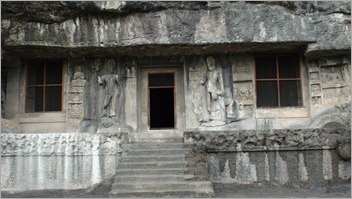 met with, and may be conventions representations of the prince who commissioned this cave and his wife. It is also possible that these are Sakra and Indra, a favorite divinity in the Buddhists and Jains.
met with, and may be conventions representations of the prince who commissioned this cave and his wife. It is also possible that these are Sakra and Indra, a favorite divinity in the Buddhists and Jains.
Two tall guardians or dwarapalas stand by the door with lofty head-dresses, dwarfs on their sides, and a female figure with a nimbus behind her head standing between the guard and the door. The front wall is pierced with a door and two windows and much of the remaining wall is filled with images of Buddha. The roof is supported by twelve massive 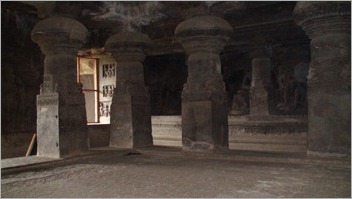 columns arranged in square and on square bases, standing on a platform which is raised 18 inches above the front and side aisles. Except the four in the back row, each pillar has dwarfs carved on the upper corners of the square portions. Above these they are circular. The area below the dwarfs is carved with a strip of design.
columns arranged in square and on square bases, standing on a platform which is raised 18 inches above the front and side aisles. Except the four in the back row, each pillar has dwarfs carved on the upper corners of the square portions. Above these they are circular. The area below the dwarfs is carved with a strip of design.
There are side galleries which run all round the wall of the hall. Each side has four pillars of different 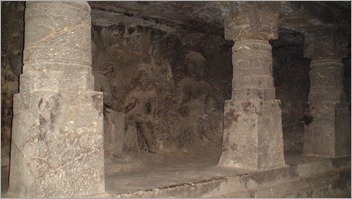 design. There are five compartments on each side and you fill find Buddha in padmasana with the usual dwarfs at side. I seemed to be like the side galleries were carved at a later time period than the main hall. The reason is that one of the sides is half complete and also accidentally, a hole was put in the floor which is above Cave 1 as I mentioned in the previous post..
design. There are five compartments on each side and you fill find Buddha in padmasana with the usual dwarfs at side. I seemed to be like the side galleries were carved at a later time period than the main hall. The reason is that one of the sides is half complete and also accidentally, a hole was put in the floor which is above Cave 1 as I mentioned in the previous post..
The dwarapalas of the main shrine as about 14 feet 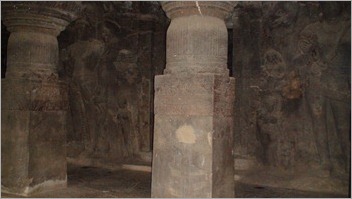 height. The one on the left is plainly dressed with his robe fastened at the waist. He has a small image of Amithabha Buddha as a crest in front. He holds a rosary in the right hand and a lotus on his left. The one on the right has a richly jeweled head-dress with a small dagoba in front. He has bracelets and armlets and has a janvi (normally worn by Brahmans) and has a small bouquet of flowers in his right hand. Both are attended by a pair of dwarfs fl
height. The one on the left is plainly dressed with his robe fastened at the waist. He has a small image of Amithabha Buddha as a crest in front. He holds a rosary in the right hand and a lotus on his left. The one on the right has a richly jeweled head-dress with a small dagoba in front. He has bracelets and armlets and has a janvi (normally worn by Brahmans) and has a small bouquet of flowers in his right hand. Both are attended by a pair of dwarfs fl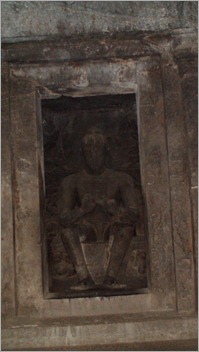 ying. Between each dwarapala and the door, is a female with the lotus in her hand. Now let us talk about the main shrine.
ying. Between each dwarapala and the door, is a female with the lotus in her hand. Now let us talk about the main shrine.
The main shrine contains a colossal Buddha seated on a throne borne at the corners by lions., and hence called a sinhasana. With the thumb and forefinger of his right hand, he grasps the little finger of his left, through the corner of which passes his robe. This is a typical preaching attire of Buddha that we see very commonly across Ellora. His hair is always tied up as a knob. On each side of his head are dwarfs. At each end of his throne are attendants. On the side walls is a colossal standing figure of either a Buddha or Bodhisattva. His right hand hangs down and has a palm turned out, the left 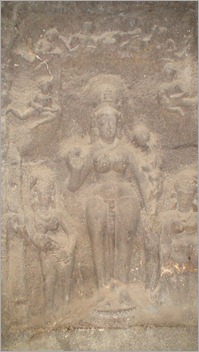 is bent upwards and holds a part of his robe. In the corners next to this two figures are four worshipping figures, one above the other. This cell is absolutely dark, but one of the least damaged.
is bent upwards and holds a part of his robe. In the corners next to this two figures are four worshipping figures, one above the other. This cell is absolutely dark, but one of the least damaged.
On each side of the sanctum is a double cell in line with the side aisles. In the outer of these and all over the front wall are figures of Buddha in various attires. The largest figure is of a female right opposite to the dwarapala on the left with a big head-dress and lotus. It may be Maya, the mother of Buddha, or Yasodhara his wife. It could as well be a female counterpart of Avalokiteswara or Padmapani. Both of her attendants have lotuses in hands.. Though somewhat abraded by time, are six Vidyadharas over the head of the goddess. Behind the head is the bhamandala, which indicates she is a celestial personage. And she wears ear rings of different forms.
The horse-shoe-shaped arch, representing the window of a chaitya, the Buddhist rail pattern is missing from this cave even though this is a place of worship and not a vihara. It can be dated to somewhere to the 3rd century., however the sculptures on the side aisles can be dated to around 7th century.
We will now visit Cave 3.
